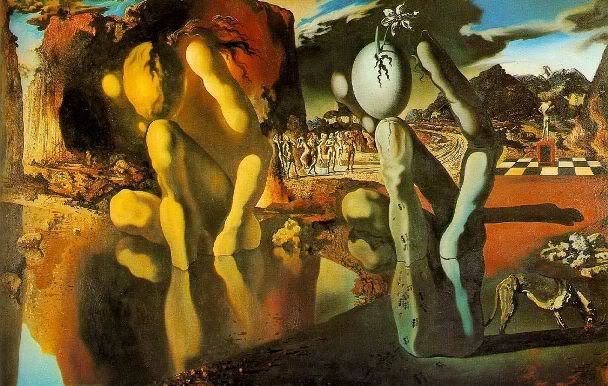Metamorphosis of Narcissus 1937 by Salvador Dali
Metamorphosis of Narcissus (1937) is a painting based on Greek mythology according to which, Narcissus fell in love with his own reflection in the water and was turned into a flower by gods.
On the left side, one of Narcissus and his reflection in a pool of water. On the right side, mimicking Narcissus' body a hand (which represents the hand of the water, as to lift its own reflection, perhaps a symbol of human ego) holding an egg held by its thumb, middle and the index fingers. A flower is breaking through the egg shell. The hand is cleverly juxtaposed to imitate Narcissus' body. The knee becomes the thumb, the left arm becomes the index finger, the right shoulder becomes the middle finger, and so forth as seen on the picture.
In the back, standing on the curve of the dirt road there are eight visible posed human figures. To the right of the painting a sculpture on a red stand on a checkered floor can be noticed. There is also a dog seemingly eating something off the ground. A closer observation of the hand and the ground underneath reveals ants, a common subject of Dali's paintings.
The left side of the painting is significantly brighter, using yellow, red and bluish colors. The right side, depicting the transformation of Narcissus is almost in the shade, painted using dark blue and gray colors.
The group of 8 people seem to be attracted by the bright Narcissus image before the transformation, almost all of the figures are wither facing each other or the viewer of the painting, the atmosphere is bright and expresses social interaction. Yet on the right side we see a single statue turned away from the viewer of the painting, intuitively suggesting loneliness and individuality.

